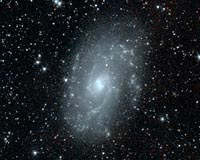 |
Pasadena CA (SPX) Aug 18, 2009 NASA's Wide-field Infrared Survey Explorer, or WISE, has arrived at its last stop on Earth - Vandenberg Air Force Base, Calif. WISE is scheduled to blast into space in December, aboard a United Launch Alliance Delta II rocket from NASA's Space Launch Complex 2. Orbiting around Earth, it will scan the entire sky at infrared wavelengths, unveiling hundreds of thousands of asteroids, and hundreds of millions of stars and galaxies. The spacecraft arrived at Vandenberg along the central California coast today, after a winding journey via truck from Ball Aerospace and Technologies Corporation in Boulder, Colo. Ball built the mission's spacecraft; its telescope and science instrument were built by Space Dynamics Laboratory in Logan, Utah. "WISE has arrived and is almost ready to go," said William Irace, the mission's project manager at NASA's Jet Propulsion Laboratory, Pasadena, Calif. "After we check the spacecraft out and fill the telescope cooling tanks with solid hydrogen, we'll mate it to the rocket and launch." WISE is an infrared space telescope like two currently orbiting missions, NASA's Spitzer Space Telescope and the Herschel Space Observatory, a European Space Agency mission with important NASA participation. But, unlike these missions, WISE will survey the entire sky. It is designed to cast a wide net to catch all sorts of unseen cosmic treasures. Millions of images from the survey will serve as rough maps for other observatories, such as Spitzer and NASA's upcoming James Webb Space Telescope, guiding them to intriguing targets. "WISE will survey the cosmic landscape in the infrared so that future telescopes can home in on the most interesting 'properties,'" said Edward Wright, the principal investigator for the mission at UCLA. The infrared surveyor will pick up the heat from a cornucopia of objects, both near and far. It will find hundreds of thousands of new asteroids in our main asteroid belt, and hundreds of near-Earth objects, which are comets and asteroids with orbits that pass relatively close to Earth. The mission will uncover the coldest stars, called brown dwarfs, perhaps even one closer to us than our closest known neighbor, Proxima Centauri, which is 4 light-years away. More distant finds will include nurseries of stars, swirling planet-building disks and the universe's most luminous galaxies billions of light-years away. The data will help answer fundamental questions about how solar systems and galaxies form, and will provide the astronomical community with mountains of data to mine. "WISE will create a legacy that endures for decades," said Peter Eisenhardt, the mission's project scientist at JPL. "Today, we still refer to the catalogue of our predecessor, the Infrared Astronomical Satellite, which operated in 1983." The Infrared Astronomical Satellite was a joint infrared survey mission between NASA, the United Kingdom and the Netherlands. WISE's survey, thanks to next-generation technology, will be hundreds of times more sensitive. The mission will scan the sky from a sun-synchronous orbit, 500 kilometers (about 311 miles) above Earth. After a one-month checkout period, it will map the whole sky over a period of six months. Onboard frozen hydrogen, which will cool the infrared detectors, is expected to last several months longer, allowing WISE to map much of the sky a second time and see what has changed. JPL manages the Wide-field Infrared Survey Explorer for NASA's Science Mission Directorate. The mission's principal investigator, Edward Wright, is at UCLA. The mission was competitively selected under NASA's Explorers Program managed by the Goddard Space Flight Center, Greenbelt, Md. The science instrument was built by the Space Dynamics Laboratory, Logan, Utah, and the spacecraft was built by Ball Aerospace and Technologies Corp., Boulder, Colo. Science operations and data processing will take place at the Infrared Processing and Analysis Center at the California Institute of Technology in Pasadena. Caltech manages JPL for NASA. NASA's Launch Services Program at the Kennedy Space Center in Florida is responsible for government oversight of the Delta II and launch countdown management. Share This Article With Planet Earth
Related Links WISE Space Telescope News and Technology at Skynightly.com
 Spitzer Sees The Cosmos Through Warm Infrared Eyes
Spitzer Sees The Cosmos Through Warm Infrared EyesPasadena CA (SPX) Aug 13, 2009 NASA's Spitzer Space Telescope is starting a second career and taking its first shots of the cosmos since warming up. The infrared telescope ran out of coolant May 15, 2009, more than five-and-a-half-years after launch. It has since warmed to a still-frosty 30 degrees Kelvin (about minus 406 degrees Fahrenheit). New images taken with two of Spitzer's infrared detector channels - two ... read more |
|
| The content herein, unless otherwise known to be public domain, are Copyright 1995-2009 - SpaceDaily. AFP and UPI Wire Stories are copyright Agence France-Presse and United Press International. ESA Portal Reports are copyright European Space Agency. All NASA sourced material is public domain. Additional copyrights may apply in whole or part to other bona fide parties. Advertising does not imply endorsement,agreement or approval of any opinions, statements or information provided by SpaceDaily on any Web page published or hosted by SpaceDaily. Privacy Statement |